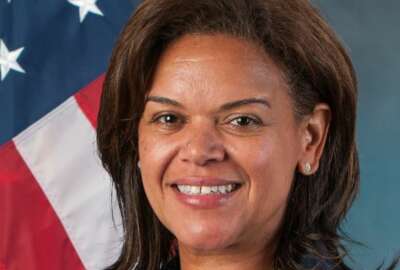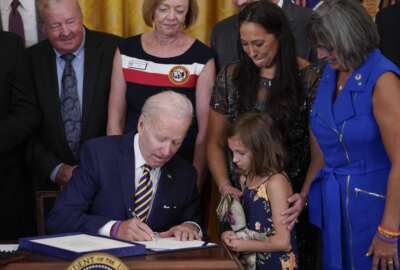
Why Veterans Affairs has persistent issues with managing acquisition
According to Government Accountability Office auditors, VA falls short and planning and managing its crucial acquisition workforce.
Best listening experience is on Chrome, Firefox or Safari. Subscribe to Federal Drive’s daily audio interviews on Apple Podcasts or PodcastOne.
As the biggest civilian agency, the Veterans Affairs Department buys lots of stuff every year from building construction to aspirin. Yet, according to Government Accountability Office auditors, VA falls short on planning and managing its crucial acquisition workforce. For more on its comprehensive survey of that workforce, the Federal Drive with Tom Temin spoke with the GAO’s director for contracting and national security acquisitions, Shelby Oakley.
Interview transcript:
Tom Temin: This was a survey, first of all, well, let’s begin with the scope of the acquisition workforce at VA. It’s not just a few people, is it?
Shelby Oakley: It’s definitely not. It’s a very large workforce about over 16,000 people. And, you know, this includes folks such as contracting officers and contracting officer representatives that are responsible for managing and monitoring contract execution and programs and project managers. And at VA, they’re spread out over VA’s many different organizations. And so it’s a very vast and dispersed workforce.
Tom Temin: And you decided to survey them, what were you trying to get out here in talking to them?
Shelby Oakley: We identified VA acquisition management as high risk in 2019. And one of the reasons why we did that is because over and over again, in our work on VA acquisition management, we kept hearing information from VA’s acquisition workforce about their workload and their access to training. And that’s definitely a range of issues that affected their ability to effectively do their jobs. And so we decided to undertake this work to ask them about those topics; how do you think about your workload, how you are rated, how your performance is managed, what training you have access to, and what opportunities there are for you for promotion potential, and how VA uses flexibilities or incentives to retain its workforce. So we asked about a broad range of questions across this workforce. And we were trying to really understand the sense of the acquisition workforce in general.
Tom Temin: And what was your survey methodology? Was it conversations in person or an instrument that they filled out a form or combination of both?
Shelby Oakley: Yeah, so we actually sent a survey, an actual web-based survey, out to a generalizable sample of the acquisition workforce, so that we could project our findings to the entire workforce. And so we did a number of steps to get as many folks to respond to that survey as possible. And so once we got the survey results in and we’re able to kind of distill those results, we then held focus groups, with various members of the acquisition workforce, to get a little bit more behind what the results of those surveys were.
Tom Temin: And give us the top line results because you found satisfaction in some areas of the work but dissatisfaction in others and kind of well mezza, mezza in the rest of it.
Shelby Oakley: Yeah, exactly. When we asked the VA acquisition workforce, they were generally positive with things like the training that they got from the VA Acquisition Academy, how their immediate supervisor treated them, and the environment that those that immediate supervisor sent, and then also, the opportunities that they were provided to balance their work life with through things like telework. And so those were all pretty positive responses. But, you know, they did identify issues, not surprisingly, with their workload, as well as how they’re rated and assessed; their performance management, you know, the steps that VA has taken to retain and recruit employees, and then just generally leadership received lower marks across VA.
Tom Temin: And were you able to quantify this in some way?
Shelby Oakley: Yeah. So our report includes a lot of data and a lot of percentages, but get let me give you a sense. So 80% of the workforce that we surveyed identified that they were happy with their immediate supervisor. Conversely, only 16% of the workforce agreed that their performance expectations are reasonable. So you can kind of see that whenever 84% of your workforce doesn’t think that their performance expectations are reasonable. There’s a challenge there that needs to be addressed by VA leadership.
Tom Temin: We’re speaking with Shelby Oakley, she is the GAO’s director for contracting and national security acquisitions. And in the report, you said that, you know, leadership really needs to do a better job of understanding, measuring and having a sense of the scope of the workforce and the issues there, maybe elaborate on that point.
Shelby Oakley: Sure. So to be able to do our survey, we wanted to collect information about the entirety of the workforce. Give us your data give us your information on the entirety of this workforce. That was a real challenge for VA, it took six plus months for us to get reliable data to be able to survey that acquisition workforce. And what we found is that VA couldn’t really produce comprehensive data on this workforce, they didn’t have information on certification levels, education levels, tenure, retirement eligibility, those types of things. Also, where they’re located was a challenge. So you know, as I mentioned, this is a very dispersed workforce across different administrations. And it was difficult for VA to have comprehensive data on that. And so we identified some issues with that. And there are system-related issues that are driving that. The the systems that are available to VA aren’t necessarily intended to provide that information. And so we made some recommendation to VA to really take steps to obtain that data. And that might mean reconciling data between the various systems that it uses to identify information on its acquisition workforce.
Tom Temin: Got it. And is there any sense I know, this might have been outside of the scope of this particular study, but does this all add up to challenges in the way VA goes about acquisition? Because we’ve seen some acquisitions not come out so well, in recent years?
Shelby Oakley: Yeah, I mean, I think the bottom line is right, you can’t without having comprehensive data on your workforce, such as you know, its size, its location and capabilities. You can’t really make data-driven human capital decisions about how to rebalance workload, how to shift resources to meet your most pressing needs. And I think that that’s a key point. This acquisition workforce supports these huge acquisitions, such as the electronic health record system and their new financial management system. And so without a really well-trained workforce that has the capacity to be able to do that, it’s going to be a struggle. And really having this data underpins being able to make good decisions about where you put your resources and who you have in place to manage these big acquisitions.
Tom Temin: It strikes me the implications really cut across a lot of functions. One is the human capital or HR function. One is the IT function to be able to extract the data needed. And of course, it’s also the acquisition and contracting function itself.
Shelby Oakley: Yeah, I mean, this data, we had to work with many different offices to obtain this data, right, because as you mentioned, HR plays a role. The Office of Contracting, Acquisition and Logistics plays a role. So there’s a number of folks that play a role in ensuring that this data is available and ready for decision makers to manage that workforce. And so it becomes much more complicated in that regard.
Tom Temin: And when you really think about this, every agency, every department should have this kind of data about every function group, across the whole government, right?
Shelby Oakley: Absolutely. Yeah. And as you know, we have human capital management as a high risk area government wide because of issues just like this.
Tom Temin: And what were VAs executives acceptance? Do they agree with you and say, Yeah, you’re right about this?
Shelby Oakley: Yeah. I mean, we didn’t want to just hear from the employees, right, we wanted to talk to VA leadership and ask them about, like, what do you know about this? What are you doing about this? What’s your take on this? I think that they definitely acknowledged the things that we were hearing, because they had been hearing the same types of things. They agreed that workload and performance management are challenges and they are taking steps to address some of these issues, or they’re putting in place some action plans to really think about that workload issue across the organization and developing some tools to have better quantitative information upon which to make decisions. And they’re requiring things like supervisors to meet with their staff regularly to discuss performance expectations. We definitely want to acknowledge that they’re doing that. But one thing we did find is that the office responsible for writ large, managing the acquisition workforce doesn’t really have direct authority over probably the majority of the acquisition workforce. And so we pointed out in our report that those roles and responsibilities throughout VA for managing the acquisition workforce, including training it knowing what you have, really need to be better documented so that everybody understands the role that they play in ensuring this workforce is well-equipped and able to execute those acquisitions.
Eric White: Shelby Oakley is director of contracting and national security acquisitions at the Government Accountability Office.
Copyright © 2025 Federal News Network. All rights reserved. This website is not intended for users located within the European Economic Area.
Tom Temin is host of the Federal Drive and has been providing insight on federal technology and management issues for more than 30 years.
Follow @tteminWFED
Related Stories

After favorable Best Places to Work results, VA pushes further workforce improvements




